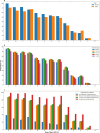Medication use patterns and polypharmacy among elderly in Iran: a cross-sectional study using national health insurance claims data
- PMID: 40840984
- PMCID: PMC12374635
- DOI: 10.1136/bmjopen-2024-097863
Medication use patterns and polypharmacy among elderly in Iran: a cross-sectional study using national health insurance claims data
Abstract
Objectives: Polypharmacy, defined as the concurrent use of multiple medications, is a growing concern among the elderly, especially in low-income and middle-income countries such as Iran. This study aims to explore the prevalence and patterns of polypharmacy among the elderly in Iran, using health insurance claims data to identify common drug classes and coprescribed medications, with a focus on informing policy decisions and improving medication management.
Design: Retrospective population-based observational study.
Setting: Nationwide data from the Iran Health Insurance Organization (IHIO) across 24 provinces.
Participants: 1 876 527 individuals aged 65 years and older, insured by the IHIO from 2014 to 2017. Individuals with incomplete demographic information or lacking medication records in the database were excluded from the analysis.
Primary and secondary outcome measures: Prevalence and patterns of polypharmacy, demographic factors associated with polypharmacy, and common drug classes used. Medications were classified using the Anatomical Therapeutic Chemical system. Polypharmacy was defined as the use of five or more medications, with cumulative polypharmacy considering total drug use over time, and consecutive polypharmacy focusing on the frequency of monthly drug use. Logistic regression and association rule mining were applied to explore demographic factors and medication patterns associated with polypharmacy.
Results: Of the study population, 74.9% experienced cumulative polypharmacy over 6 months and 64.6% over 1 month, with 7.6% experiencing consecutive polypharmacy. Females and those aged 75-79 were more prone to polypharmacy. Systemic glucocorticoids were the most commonly used medications (50.02%), followed by HMG-CoA reductase inhibitors (42.73%) and platelet aggregation inhibitors (41.92%). Polypharmacy was most strongly associated with medications related to the alimentary tract and metabolism, cardiovascular system, nervous system and blood and blood-forming organs.
Conclusions: Polypharmacy is highly prevalent among the elderly in Iran, with significant variations by gender, age, insurance fund and region. The findings highlight the need for targeted interventions to manage polypharmacy and improve medication safety in this population.
Keywords: Aged; Polypharmacy; Prescriptions; Prevalence.
© Author(s) (or their employer(s)) 2025. Re-use permitted under CC BY-NC. No commercial re-use. See rights and permissions. Published by BMJ Group.
Conflict of interest statement
Competing interests: None declared.
Figures


Similar articles
-
Prescription of Controlled Substances: Benefits and Risks.2025 Jul 6. In: StatPearls [Internet]. Treasure Island (FL): StatPearls Publishing; 2025 Jan–. 2025 Jul 6. In: StatPearls [Internet]. Treasure Island (FL): StatPearls Publishing; 2025 Jan–. PMID: 30726003 Free Books & Documents.
-
Prevalence, safety evidence, and determinants of medicine use during breastfeeding among women in Kampala, Uganda.BMC Womens Health. 2025 Aug 11;25(1):387. doi: 10.1186/s12905-025-03939-1. BMC Womens Health. 2025. PMID: 40790485 Free PMC article.
-
Interventions to improve the appropriate use of polypharmacy for older people.Cochrane Database Syst Rev. 2018 Sep 3;9(9):CD008165. doi: 10.1002/14651858.CD008165.pub4. Cochrane Database Syst Rev. 2018. Update in: Cochrane Database Syst Rev. 2023 Oct 11;10:CD008165. doi: 10.1002/14651858.CD008165.pub5. PMID: 30175841 Free PMC article. Updated.
-
Investigation and analysis of mental health status of the older adult in western rural areas.Front Public Health. 2025 Jul 16;13:1612600. doi: 10.3389/fpubh.2025.1612600. eCollection 2025. Front Public Health. 2025. PMID: 40740371 Free PMC article.
-
Interventions to improve the appropriate use of polypharmacy for older people.Cochrane Database Syst Rev. 2023 Oct 11;10(10):CD008165. doi: 10.1002/14651858.CD008165.pub5. Cochrane Database Syst Rev. 2023. PMID: 37818791 Free PMC article.
References
-
- World Health Organization . Geneva: World Health Organization; 2019. Medication safety in polypharmacy: technical report. Contract No.: WHO/UHC/SDS/2019.11.
Publication types
MeSH terms
LinkOut - more resources
Full Text Sources
